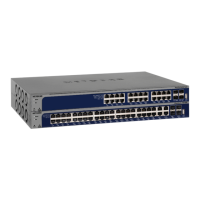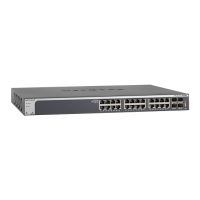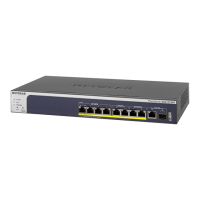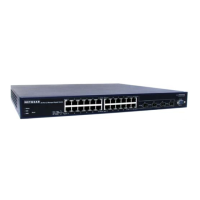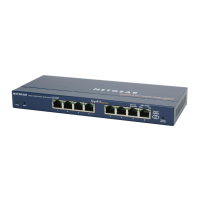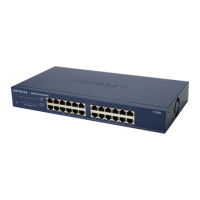Configure Quality of Service
249
XS708T, XS712Tv2, and XS716T Smart Managed Pro Switch User Manual
Delete a DiffServ Class
To delete a DiffServ class:
1. Connect your computer to the same network as the switch.
You can use a WiFi or wired connection to connect your computer to the network, or
connect directly to a switch that is off-network using an Ethernet cable.
2. Launch a web browser.
3. In the address field of your web browser, enter the IP address of the switch.
If you do not know the IP address of the switch, see Change the Default IP Address of the
Switch on page 10.
The login window opens.
4. Enter the switch’s password in the Password field.
The default password is password.
The System Information page displays.
5. Select QoS > DiffServ > Advanced > Class Configuration.
The Class Name page displays.
6. Select the check box next to the class name.
7. Click the Delete button.
The class is removed.
Configure DiffServ IPv6 Class Settings
The IPv6 class configuration feature extends the existing QoS ACL and DiffServ functionality
by providing support for IPv6 packet classification. An Ethernet IPv6 packet is distinguished
from an IPv4 packet by its unique Ethertype value, so all IPv6 classifiers include the
Ethertype field. An IPv6 access list serves the same purpose as its IPv4 counterpart.
Before the introduction of the IPv6 class feature, any DiffServ class definition was assumed
to apply to an IPv4 packet. That is, any match item in a class rule was interpreted in the
context of an IPv4 header. An example is a class rule that specifies an L4 port match value.
With the introduction of the IPv6 match capability, you must specify if this class rule is for IPv4
or for IPv6 packets. To facilitate this distinction, a class configuration parameter is added to
specify whether a class applies to IPv4 or IPv6 packet streams.
The destination and source IPv6 addresses use a prefix length value instead of an individual
mask to qualify them as a subnet addresses or a host addresses. The flow label is a 20-bit
number that is unique to an IPv6 packet, used by end stations to signify some form of Quality
of Service (QoS) handling in routers.
Packets that match an IPv6 classifier are allowed to be marked using only the 802.1p (CoS)
field or the IP DSCP field in the traffic Class octet. IP precedence is not defined for IPv6. This
is not an appropriate type of packet marking.

